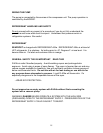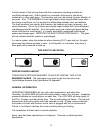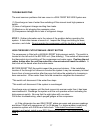
25
A white stream of fast moving foam with the compressor operating indicates an
insufficient charge level. Watch closely for a transition from foam to total liquid,
indicated by a clear sight glass. This transition point can be missed if proper attention is
not given. Also, IT IS POSSIBLE for the sight glass to show large bubbles even when
the charge is sufficient, so it is important to differentiate between foam and bubbles.
The foam condition has velocity and direction; the bubbles are large, temporary, and
nearly stationary. Do not try to chase away these larger bubbles with more refrigerant;
overcharging must be avoided. Air in the system may give a false sight glass reading,
which could lead to overcharging. If in doubt, discharge a suspected overcharged
system and charge again. MONITOR THE SIGHT GLASS CONTINUALLY. The glass
will not indicate when the system is overcharged.
In a warm system, when the plates are above freezing (32.F) upon start-up, the sight
glass may take several minutes to clear. A cold system, in cold water, may show a
clear glass within seconds of start-up.
RFD SIGHT GLASS DETAIL
CLEAR (OR EMPTY) STATIONARY BUBBLES FOAM/LOW
PROPER CHARGE AMOUNT
THE BG 2000 SYSTEM IS DESIGNED TO HOLD 24 OUNCES. THIS IS THE
MAXIMUM CHARGE. The sight glass must clear by the time the return line
(suction/large diameter tube) goes below 32 degrees F.
GENERAL INFORMATION
OPERATING PRESSURES will vary with water temperature, and water flow.
Generally, the HIGH SIDE will peak with warm plates in two to four minutes. Increasing
pressure indicates an overcharge or no water flow. The LOW SIDE will drop rapidly to
the 20 to 10 range, and then slowly drop. The low side tubing will freeze. The low side
pressure will drop more rapidly when the seawater is cold. A deep vacuum indicates
the system is frozen with moisture or the valve is plugged with dirt or contaminants.
Failure to "pull down" indicates the valve is malfunctioning or flooding.
The compressor will feel warm in normal operation.
Every valve has been operated prior to shipment. There are no field superheat
adjustments.


















